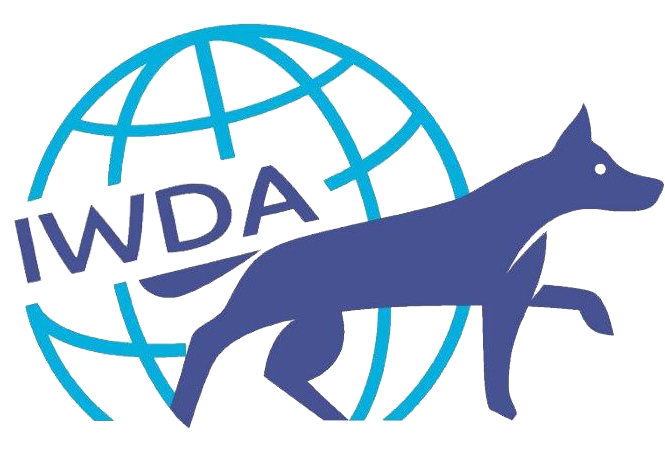Search for working dog conference recordings, articles on health, breeding, socialization and organizational management, webinar recordings and more.
Old Conference Archive Page | View all IWDC 2023 Recordings | View all Breeder's Workshop Colorado Recordings
-
Organization Management
-
Canine Resources
-
-
-
- Emotional Conflict During Socialization
- What is environmental enrichment?
- Distance, Distraction and Duration
- Developing Foundational Skills
- Luring, Marking & Giving Food
- 5 Steps to Progressing Skills
- Dog-Human Relationship Skills
- Utilizing Volunteers
- Biosecurity
- Biosecurity protocol documents
- Example Socialization Schedule
- Puppy Socialization Tracker
- Crate Training
- Managing Inappropriate Interactions between littermates
- Preventing and Fixing Door Dashing
- Follow Me: Video
- Bath Progression: Video
- Intro to New Environments: Video
- Motor Development: Video
- Novel Objects: Video
- Novel Sounds: Video
- Trolley Ride: Video
- Wearing Things/Coat Desensitization: Video
- Carrying Puppies Safely
- Safely Using Stairs: Video
- Puppy Confidence Course
- Socialization Ideas Gallery
- Show Remaining Articles ( 12 ) Collapse Articles
-
- Articles coming soon
-
Education
-
-
- A Behavioral Questionnaire for Selection and Study of Odor Detection Dogs - Presented by Cynthia Otto
- Audeamus PTSD Service Dogs, ACAC Accredited Peer-Support Model for Veterans and First Responders - Presented by Chris Lohnes and Grace Rath
- Audeamus Service Dogs and University of Saskatchewan Research Partnership and Outcomes - Presented by Chris Lohnes & Grace Rath
- Building a Purpose Bred Breeding Program - Presented by Allison Peltier and Rachel Goldammer
- Core body temperature and activity level changes during work and exercise in patrol dogs of the Queensland Police Service - Presented by Jayne McGhie
- Detection of Heterobasidion parviporum scent samples in indoors scent discrimination test by trained volunteer dog-handler teams - Presented by Heli Väätäjä
- Development of a Tool to Aid in the Selection and Pairing of Breeders based on Behavioral Traits - Presented by Jordan Smith
- Early Detection of Heat Stress in Working Dogs - Presented by Andrea L. Henderson
- Effects on behavior and physiology of handling style during veterinary visits - Presented by Karen Overall
- Field cooling for exertional hyperthermia - Presented by Cynthia Otto
- From Anxious to Resilient: The Role of Dynamic Interactive Engagement in Shaping Military Working Dogs - Presented by Melanie Uhde
- Genetic Resources to Improve Dog Health - Presented by Angela Hughes (Royal Canin)
- Genomic research in the Working Dog Field: Combating Canine Cancer through Collaboration and Comparative Oncology Research - Presented by Frances L. Chen
- Handler Perceived Risks to Operational Detection and Patrol Police Dogs - Presented by Jayne McGhie
- Improving Trauma Patient Care - Presented by Kelly Hall
- Neuromuscular Balance Training in Working Dogs - Presented by Andrea L. Henderson
- Occupational Risks and Specialized Veterinary Care for Working Dogs - Presented by Cynthia Otto
- Putting working dog research into practice: development of science-based guidance notes - Presented by Fiona Williams
- Rating of Perceived Exertion in Working Dogs - Presented by Andrea L. Henderson
- Real-world experience with liquid biopsy testing for cancer detection in working dogs - Presented by Jill Rafalko
- Specialty Practice Behavioral Problems and Outcomes in Companion Dogs - Implications for Working Canines - Presented by Walt Burghardt
- Start of life – Feeding during pregnancy and lactation to increase reproductive success - presented by Angela Hughes (Royal Canin)
- Teaching Collar Yielding as a Foundation Behavior - Presented by Patrick Glines
- The Doberman Diversity Project: a Citizen Science approach to breed improvement - Presented by Sophie Liu
- The effect of inhibitory control, arousal, and affective state in Military Working Dogs Performance - Presented by Astrid Concha
- The effect of training aid volume on odor generalization in detection of chronic wasting disease in deer - Presented by Mallikarjun and Wilson & Cindy Otto
- The Many Dogs Project: A Big Team Canine Science Effort - Presented by Sarah-Elizabeth Byosiere
- Transformative Power of Freedom of Choice in Changing Behavior - Presented by Marty G. Roache
- Turning a Critical Eye on an Established Breeding Program to Improve End Results Using IWDR - Presented by Natalie Ergler and Rachel Goldammer
- U.S. Military Working Dog Welfare - Presented by Desireé Broach
- What is the future of Biological Detection Canines? - Presented by Heather Junqueira & Ken Furton
- Working dog memory and canine gut microbiome - Presented by Xu Wang
- Show Remaining Articles ( 17 ) Collapse Articles
-
- Breeding Healthy Dogs - Presented by Madeline Zimmermann
- Choosing What to Breed For - Presented by Madeline Zimmermann
- Gaiting - with Doug & Colton Johnson
- Genetic Merit Selection - Presented by Madeline Zimmermann
- Improving Behavior - Presented by Jane Russenberger & Dr. David Roberts
- IWDR: Storing your Data - Presented by Rachel Goldammer
- Keep Data on Everything! - Presented by Rachel Goldammer
- Long-Term Colony Management: Balancing genetic improvement breeding for the whole dog - Presented by Dr. Eldin Leighton
- Power of Numbers: IWDR Functions - Presented by Rachel Goldammer
- Producing Puppies - Presented by Dr. Fiona Hollinshead and Dr. Greg Burns
- Puppy Socialization - Presented by Jane Russenberger
- Puppy Socialization for Handling - presented by Doug & Colton Johnson
- Reading Dog Behavior/Emotional States - Presented by Dr. Karen Overall
- Whelping and Neonatal Care - Presented by Dr. Fiona Hollinshead and Dr. Greg Burns
-
- "All about the boy" - Semen Collection and Analysis - presentation by Dr. Fiona Hollinshead
- All about the brood - presentation by Dr. Greg Burns
- Behavior Checklist (BCL) Workshop - with Helen West
- Behavioral scoring in Puppy Raising - presentation by Helen West
- Brood and Whelping Concerns - presentation by Dr Greg Burns
- Calculating Differential Risk of Osteoarthritis in Dogs with Low vs High Hip Scores - presentation by Dr Tom Lewis
- Cardiac diseases - presentation by Dr Kevin Conrad (absent); presented by Dr. Kyle Quigley
- Conditioning Program for Dogs Coming In For Training - presentation by Dr Kevin Conrad (via zoom)
- Critical periods of socialization and impact on temperament of the dog - presentation by Jane Russenberger
- Does early potty training affect indiscriminate relieving? - presentation by Dr Lynna Feng
- Dog behavior is in the eye of the beholder - presentation by Joke Monteny
- Entropion - presentation by Jenna Bullis
- Feeding for Breeding Success - presentation by Dr. Emmanuel Fontaine
- Gait and Structure Evaluation for Guide Dogs - presentation by Peggy Gibbon and Dr Katy Evans
- GDBart Puppy Test - presentation by Helen West
- Healthy microbiome and faecal transplants - presentation by Dr Kevin Conrad (absent); presented by Dr Caroline Moeser
- Hip and elbow assessments - with Dr Bart Broeckx
- How to make breeding decisions on traits without EBVs - presentation by Madeline Zimmermann
- How to use estimated breeding values successfully - presentation by Madeline Zimmermann
- Improving behavior with EBVs: Body sensitivity, Noise Fear, Inhibited by Stress, Activated by Stress, Excitable - presentation by Jane Russenberger
- Improving health using EBVs: Elbow, Skin and Mast cell tumours - presentation by Madeline Zimmermann
- Is it really epilepsy? - with Dr Bob Proesmans & Dr Caroline Moeser
- Neonatal Care - presentation by Dr Emmanuel Fontaine
- Reproductive Trends and Cryogenic Insights from Guiding Eyes - presentation by Clover Williams
- Selecting Reproductively Healthy Dogs - presentation by Dr Emmanuel Fontaine
- Skin allergies - with Dr Caroline Moeser
- Stargardt's disease in Labrador retrievers - with Dr Katy Evans
- Strategies for genetic diversity - presentation by Jackie Clark and Dr Bart Broeckx
- Superficial Digital Flexor Tendon Avulsion - presentation by Dr Caroline Moeser
- The art of insemination - presentation by Dr. Fiona Hollinshead
- The Overall Selection Index - presentation by Dr Eldin Leighton
- What influences semen quality? - presentation by Dr. Tom Lewis
- Show Remaining Articles ( 17 ) Collapse Articles
-
- A detailed evaluation of Spotted Lanternfly (Lycorma delicatula) detection dog training and performance - Presented by Edgar O. Aviles-Rosa
- A novel method for the detection of Japanese knotweed (Reynoutria japonica) using specially trained canines - Presented by Kat Janczur
- AKC Detection Dog Task Force Program: Working with AKC Breeders to Improve Breeding & Availability of Explosives Detection Dogs - Presented by S Goffe
- Assessing working dog fitness with the Penn Vet Working Dog Center Fit To Work program - Presented by Brian Farr
- Assessment of the Agreement between Fosters and Trainers Evaluating Behavior with the C-BARQ and Behavior Checklist presented by Elizabeth Hare
- Behaviour Assessment and IWDR - Presented by Dr Jane Russenberger
- Breeding Strategies and Advanced Reproductive Techniques to Optimize Production of Improved Generations of Specialized Canines at Three major working dog breeding programs in New Zealand - presented by Dr Fiona Hollinshead
- Development and heritability of cognitive traits in Canine Companions dogs presented by Emily Bray
- Digital innovation for working dogs - Presented by Dr Mia Cobb
- Discrimination between SARS-CoV-2 infection and other viral respiratory infections by working dogs - Presented by Nele ten Hagen
- Effect of impulsivity and core effect on training performance in dual purpose military working dogs - Presented by Astrid Concha
- Epilepsy in working dogs - Presented by Prof Holger Volk
- Estimated Breeding Values in IWDR - Presented by Dr Eldin Leighton
- Examining the Role of Significant Others in Canine Welfare within the Context of Veterans Working with Service Dogs - Presented by Linzi Williamson
- Explosive detection canine operational requirements and performance degradation: expert perspectives - Presented by Brian Farr
- Hot Topics in Working Dog Care - Presented by Dr B. Pierce & Dr K. Mann
- Implementation of a plan to decrease arousal and increase motivation - Presented by Robert Dougherty Jr and Alena Heyer
- Improving behavior monitoring within a working dog program - Presented by Becky Hunt
- Incidence of enteric pathogens versus presence of gastrointestinal symptoms in a working dog training facility - Presented by Dr Nicola Cotton
- Investigation of tail injury at Lackland Air Force Base Training Kennels for Military Working Dogs - Presented by Marty G. Roache & Karen L. Overall
- Learning to Smell: Impacts of Training and Experience on Detection Dog Performance - Presented by Nathaniel Hall
- Lecture on Generalization in Detection Work - Presented by Hans Ebbers
- Liquid biopsy screening for early cancer detection in working dogs - Presented by Katherine M. Lytle, DVM, MPH, MS
- Military Working Dog Aggression and Welfare - Presented by Desiree Broach
- Multimodal characterization of detection dog suitability: Combining behavioral, cognitive, and neurological measures for enhancing selection - Presented by Lucia Lazarowski
- Overview of the IWDR for Working Dog Organizations - Presented by Dr Eldin Leighton
- Pandemic or pandemonium? Creating standards for medical detection dogs - Presented by Dr Cynthia Otto
- Penn Vet Working Dog Center Fit To Work program foundational fitness development and training - Presented by Meghan Ramos
- Preliminary Accuracy of COVID-19 odor detection by canines - Presented by Kenneth G. Furton
- Prevalence of Canine Degenerative Myelopathy SOD-1 Mutation in Working Shepherd Dogs across Australia and New Zealand - Presented by Jayne McGhie
- Scent dog identification of SARS-CoV-2-infections- a double blind study - Presented by Esther Schalke
- Solving cold-cases: Dogs can match human scents collected several years apart - Presented by Margot Perez
- The Application / Practical Implementation Pro/Cons of Covid-19 Olfactory Detection Dogs - Presented by Prof D Grandjean
- The Domestic Breeding Consortium: Odor Detection Canine Selection, Breeding, and Early Training Techniques - Presented by Karen Meidenbauer
- The effect of maternal style on later puppy behavior in Canine Companions dogs - Presented by Brenda Kennedy
- The use of historical health records at The Seeing Eye in genome-wide association studies for canine health traits presented by Katy M. Evans
- Training with Varying Odor Concentrations: Implications for Odor Detection Thresholds in Canines - Presented by Mallory DeChant
- Transitioning a Therapy Dog Program Online: What's In It For the Dog? - Presented by Ben Carey
- Using IWDR's Advanced Tools to Improve HeaLth and Behaviour - Presented by Dr Eldin Leighton
- Using Single-Step Genomic BLUP to Compute Genomic Enhanced Breeding values for Self-Modulation in Working Dogs presented by Molly Riser
- Using trained dogs and organic semi-conducting sensors to identify asymptomatic and mild SARS-CoV-2 infections - Presented by Dr Claire Guest and Prof James Logan
- Working Dog Welfare: Where are we now and where are we going? - Presented by Dr Mia Cobb
- Show Remaining Articles ( 27 ) Collapse Articles
-
- A canine thermal model for mitigation of heat strain in working dogs - Presented by C. O'Brien
- Building a better detector dog: Lessons learned and (many) questions remaining to be explored in Auburn University’s 19 years of detector dog production - Presented by P. Waggoner, PhD
- From Puppyhood to Adolescence: Longitudinal Cognition Study at Canine Companions for Independence - Presented by K. Levy
- Genome-wide association studies to identify loci and variants associated with behavioral traits in dogs - Presented by V.D. Marinescu, PhD
- Hyper-reactivity in military working dogs: a report of two cases - Presented by O. Soares, DVM, PhD
- Measuring, and determining factors affecting performance of glycemic alert dogs - Presentation by N. Rooney, PhD
- Neuromotor development in puppies: implications for training and fitness - Presented by B. Pierce, DVM, MS, DACVIM, DACVP, DACVSMR
- Odour generalisation – theory and practice - Presented by A. Schoon, PhD
- Putting working dog research into practice: development of science-based guidance notes - Presented by V. Ratcliffe, PhD
- Referential focus - pet & working dogs - Presented by K. Overall, MA, VMD, PhD, DACVB
- Statistics for working dogs – how do you know if your test/assessments are better than a coin toss? - Presented by A. Dunham, PhD
- Temperament and EBV - Presented by Erling Strandberg, PhD, SKK
- Testing dogs for behaviour in Sweden: Canine temperament - assessment and heritability & How you assess temperament - presented by Åke Hedhammar DVM, PhD & Kenth Svartberg, PhD
- The chemistry of odor: How understanding odor can foster a better detector - Presented by L. De Greeff, PhD
- The opioid crisis and working dogs - Presented by C. Otto, DVM, PhD, DAVCECC
- What helps and what hinders assistance dog/puppy raising practices? - Presented by Doc Loc Mai (Jimmy)
- Working Dog Centre: Working hard for working dogs - Presented by W. Baltzer, DVM, PhD
- Show Remaining Articles ( 2 ) Collapse Articles
-
-
-
-
Payment and Accounts
Delayed Placements (Week 9+)
0 out of 5 stars
| 5 Stars | 0% | |
| 4 Stars | 0% | |
| 3 Stars | 0% | |
| 2 Stars | 0% | |
| 1 Stars | 0% |
Quick Reference Guide

Goal
Prepare puppies for their future placements through one-on-one activities, routine development and continued socialization. Provide variety, new environments, and skill development.

Environments
Inside or outside, within your facility or externally (keeping biosecurity concerns in mind for under-vaccinated puppies).

Volunteer Activities
Volunteers can assist in socialization activities and daily routines. Make sure they are trained in body language and handling of older puppies (who may jump up, chew, bark etc more than younger age groups).
Introduction
After their 8 week vaccinations, puppies are able to begin exploring the big wide world. Many organisations aim to have their puppies in raiser/carer homes by this age but this is not always possible. The following content is aimed to provide enriching and educational activities for puppies whose placements have been delayed beyond the standard 8-10 weeks.
Depending on your available resources, you can pick activities most relevant to your organisation’s needs and abilities. Make sure to provide the puppies with a regular routine. Remember, the aim is to prepare the pup for a life of ongoing learning and working, so all activities must be fun and enjoyable. Routines around feeding, toileting and basic manners that are developed during early socialization are essential to helping pups settle into their new carer homes with less stress to both the pup and the carer.
It is important that you proceed to more advanced parts of the skills only when the pup is ready, as advancing too quickly can affect their outlook on work and learning, as well as inadvertently teaching them the wrong way to do things.
Slowly introduce more key skills and build your puppies’ self control. Make sure you and any volunteers are familiar with our guide to Emotional Conflict during Early Socialization.
- Pups are socially polite around people. They do not bite hands, shoes or ankles.
- Pups accept being in a crate alone for up to 10 minutes.
- Pups are developing a reliable toileting routine.
- Pups are accepting of time away from litter mates, and are not becoming co-dependent on their littermates for entertainment or support.
- When alone or in groups in a familiar situation pup readily acclimates in a new environment and/or around novel objects, noise typical of a puppy raiser’s busy home.
- Pups respond readily to being called, accept being handled for an exam or cradled on their back in your lap.
- Pups follows the handler off and on leash in a low distraction situation
- Pups accept brief body handling in the close position
- Pups are adept at climbing on and around items that are no higher than one half of their leg length.
- After all sessions, ensure you allow pups some calm, quiet time. Pups still tire easily and need a lot of sleep. Encouraging quiet time also sets the pup up to enjoy sleeping or entertaining itself when doing nothing. This is an important skill and will help the pup throughout their life, with raisers and clients, both at home and when working. Baby pens can be set up in areas you are using. This allows the puppy to sit and listen to sounds, conversations, laughter, and normal office noises. This helps teach pup to relax in between work.
- Skill building also assists in creating responsibility in the pup, so it chooses you. Build on “Follow me” and other skills that set the pup up to engage with the handler by adding check-ins (pup making eye contact with you).
- By being aware of your own body language you are starting to communicate with the pup in a language it understands. Always give clear, consistent communication to the pup so it will succeed.
- Helping the pup to be well mannered on and off the leash is achieved by using your skills to engage the pup, instead of managing using the leash or avoiding access to anything distracting.
- Continue to build your relationship with the pup so it remains attentive to you especially on walk so there is no pulling on the lead. Loose lead walking is one positive you can give to the puppy raiser to make their role easier. Concentrate on this as it is harder to learn then sit or down. The puppy raiser will thank you for helping to hand over a pup that is a pleasure to walk and responsive to handlers.
Remember all pups are individual so work at the pup’s level not at the level of other pups in the same litter. It’s all about setting the pup up for success and building human relationships.
Remember to document all that you observe. Do not attach titles like stubborn, self-centred, rather describe the context in which the behaviour occurred. For example, pup was hesitant to approach, had low body carriage, tail between its legs. Add anything you tried and what worked to help pup.
Skill building is an ongoing process and it is essential to start during the critical learning period. Some of the skills being taught will be utilised throughout the puppies’ lives while others will provide the pups with a solid foundation upon which guiding/service work can be taught.
Puppies do not naturally know what we want so it is our role to patiently teach them what we want in a calm, relaxed, enjoyable fun environment. We must maintain and then gradually build up pup’s skill level until the pup can reliably perform the skill, before moving onto the next level. Building reliable skills results in the pup responding to your commands in any situation and remaining in that position until you release it.
During skill building exercises our role is to allow the puppy to have fun while working with you and to choose you, despite any distractions. Each time we work with the pup we are building the pup’s desire to work with you instead of working for a food reward: Read more on this in the “Teaching new skills” section.
Before pups go to puppy raisers your role is to preload them with skills that they are confident to perform and understand well.
We are building up the following skills – most of which you will recognize from our work during the previous few weeks:
1. Name recognition/response
2. Sit (used in various situations such as doors or mealtime)
3. Down
4. Follow me and check in
5. Body handling & close
For these skills we use the marker word “YES” when the puppy does the right thing. For example, when teaching “sit”, we wait until the puppy’s bottom touches the ground – and that very instant we say “Yes” and then give the puppy a food reward. This builds a positive association to the word “yes”, and puppies will soon learn that when they hear “yes”, they’ve done the right thing. This is generalized easily by the puppy, and is the foundation of teaching puppies harder skills. Remember:
- “Yes!”
- Treat
- Praise
We highly recommend you read all articles linked in this section to gain an understanding of the full process and how to keep interactions with your pup positive and productive.
Skills can be taught by luring (using food to lead the puppy to the desired position) and shaping (capturing moments that the puppy is naturally in the desired position). When teaching a new skill, it is important to build on it gradually, so the pup has the best chance of succeeding. To set our pup up for success we need to make our environment and expectations as reasonable as possible: we do this by managing the “three D’s”, which are Distance, Distraction and Duration.
- Read our article on Distance, Distraction and Duration.
- Read our article on Luring, Marking, and Giving Food rewards.
As we work with our pups, it’s important we don’t overwhelm them by moving too quickly or expecting too much. One way to manage this is to keep training sessions very short and to incorporate meaningful play as both a reward for the pup (e.g. in place of a food reward) and an outlet for the pup’s emotional release – after all, we need to make learning/training an enjoyable part of our pup’s life. This should always be a focus both during these formative weeks and beyond.
As well as “sit”, “down”, recall and other obedience skills, there are a number of foundational skills you can work on that will help your puppy become a well-rounded dog. IN following this early socialization program you have already introduced some of these skills or laid a solid framework to build these skills upon.
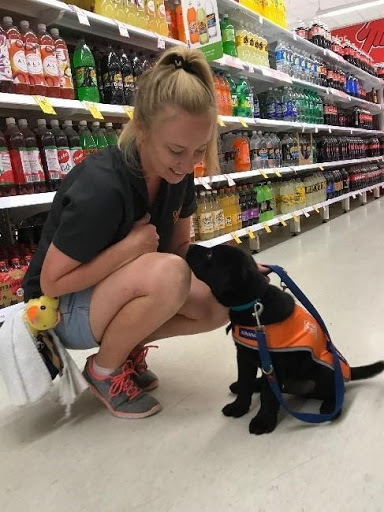
Problem Solving
Should pup not be responsive assess things like tiredness or just having an off day for learning and engaging. Consider whether the pup is stressed – can you see any stress signals? Sometimes the pup is not in a learning mode, so it is best to leave on a positive rather than teaching what you do not want from the pup. Going back to a known skill like sit then leaving has set the pup with success prior to leaving. If the puppy does appear stressed, give him some time to resolve the conflict on his own before progressing or continuing with the activity.
Here are some tips to help pups engage with a handler:
- Before beginning education session, give the puppy a few treats to establish connection with pup
- Encourage puppy to explore items in education room and reward puppy for staying connected with handler
- Use voice, praise, and petting to reward the puppy
- Keep sessions positive and engaging
This same advice applies to reactions to novel objects, elevated surfaces, underfootings, loud noises etc.
- Encourage pup to explore the noise/object or climb on the surface (making sure the surface is secure)
- Give puppy time to explore on their own
- Reward the puppy for exploring on their own
- Give puppy support when needed, such as:
- Littermates interacting with the object
- Handler interacting with the object
- Praise/encouragement for progress
- Review our Intro to New Environments video – from about 9:00 you can watch a puppy overcome a reaction to a novel object with the help of support (in the form of a littermate, but this could be achieved through handler support also).
- Keep sessions short and positive
- Record the issue and any progress made so future sessions can continue the learning.
Working on being more comfortable with body handling:
- Go slow with body handling and medical exams to allow the puppy time to process and be successful during the activity
- Praise and reward the puppy for remaining calm
- Keep body handling sessions short and positive
Working on being comfortable when being picked up and during body handling:
- Please follow the Carrying Puppies protocol when interacting with the puppies
- Please place the puppies in a designated laundry basket/trolley when moving rooms- this will let them be more comfortable when being moved
- Keep education sessions brief and positive
Working on having all 4 on the floor instead or jumping up
- When working individually with the puppy and they jump up, stand straight and wait until the puppy has all 4 paws on the floor. Praise the puppy afterwards. The puppy learns through this that it’s more rewarding to have all 4 paws on the floor than to jump up.
Working on having all 4 on the floor instead of rolling over for belly rubs
- When petting the puppy, pet them on the back
- If the puppy rolls over for a belly rub, wait until the puppy gets back up to pet them.
- Pet the puppy for being a good puppy
- If the puppy rolls over again, wait for the puppy to be on all 4s before giving them attention.
Working on chewing on appropriate items instead of mouthing:
- Try to use a calm voice when interacting with the puppy. High pitched or overly excited tones can cause them to become overly excited and increase mouthing
- Carry a soft toy with you when interacting with this puppy to redirect mouthing if needed
- Have a variety of toys out in the yard to prevent puppy from inappropriately mouthing
- If the puppy mouths on inappropriate items such as clothes or shoes, redirect them with a soft toy. Praise the puppy when they choose to the toy over inappropriate items
Demand Barking
Working on offering desired behavior of waiting patiently with all 4 paws on the floor
- If the puppy begins to bark at you when you are idle or not paying attention to them, ignore the puppy so they learn that demand barking doesn’t get rewarded. Remember, even looking at the puppy counts as giving attention to the puppy. Reward the puppy with praise or a treat when they are quiet
Whining for attention
Working on offering desired behavior of waiting patiently with all 4 paws on the floor for attention
- If the puppy begins to whine at you when you are idle or not paying attention to them, ignore the puppy so they learn that whining doesn’t get attention. Remember, even looking at the puppy counts as giving attention to the puppy. Reward the puppy with praise or a treat when they are quiet
- Our goal is for the puppy to learn that we will bring the treat to them
- Give the puppy treats using a flat hand
- If the puppy jumps up and tries to use their mouth to grab the treat, close your hand and stand up until the puppy has all 4 on the floor.
- Once the puppy has 4 on the floor, you can begin again
Activation
- Give puppy time to process after stressful events
- Keep toys with you and in the education room to redirect mouthing
- Use a calm and even voice when working with pups to prevent them from becoming over excited
- Keep sessions brief and positive
Inhibition
- Give puppy support when needed
- Take things slow with puppy and give them time to process
- Focus on confidence boosting activities
Signs that tell you the pup needs immediate help include:
- Severe change in energy-inhibited or activated, not engaged
- Long period of time needed to resume activity
- Fight or flight response- Puppy is not actively learning
If pup is in the red zone review your technique and ensure you are working pup at a level that ensures success. Sometimes going back to an earlier skill level and building up again can be helpful. Reduce the 3 D’s and make sure you are giving puppies enough time to rest. Consider the stimuli that caused the reaction and why. Was there one major event or a number of small events?
Always focus on the fundamentals initially then gradually build up the new key skill. When teaching a new skill, it is important to build on it gradually, so the pup has the best chance of success. it is best to practice the new skills multiple times in a variety of situations.
The progression of the new skill in small slices is paramount while increasing duration, providing more distractions or while at a greater distance – yet alone when trying to combine any two or all three.
This all takes time so start slowly and remember short positive sessions are best. Multiple brief sessions can be done throughout the day to assist the put to process the skill. Although food reward can be used initially but the aim is to have your pup choose you and focus on you not the food reward. This is important when trying to work through a distraction.
Always acknowledge when your pup does check in with you. Food is not the reward but the use of you through your body language like a smile, verbal praise, or change in energy so pup knows it has done well and you are extremely pleased.
The pup is learning that being with humans is fun. Over the past weeks the building of human relationships will start to show benefits with the pup choosing you most times.
Should something not be working then change what you are doing! Consider what does and doesn’t work for your individual puppy. Why is the pup not performing – is it stressed, tired, ill, distracted, disinterested?
This is the time to employ distancing. Use your relationship skill to get the pups attention back on you.
Reward highly and generously for the pup choosing you by using your body language/ puppy skills – smiles, verbal praise, a happy voice. Have pup practice a known reliable skill like sit, to allow you time to assess the best way to continue so the pup is successful.
It might mean going back a few steps so reinforce the behaviour you want then trying again. The use of another person to mimic the previous setting with clear instructions on how you want them to help the pup success can often be beneficial.
Interrupt verbally if pup starts to scavenge (Ah ah!). Use your skills to make sure pup chooses you over the item. Remove anything from their mouths that they pick up.
Troubleshooting for Excessive Scavengers
If you see something the pup is likely to scavenge, pre-empt this by tickling them on their side or talking to them to distract them as they go past it. Your role is to ensure the pup chooses you over a distraction, because you are more fun. By pre-empting you help to set the pup up for success. *In severe cases/emergencies you can use a lure to guide the pup past a distraction, but use this as a last resort. The pup should be engaged and working with the handler.
Make sure all meals are fed in the crate. Increase support of the puppy in the crate: reward for short periods of calmness and work on progressing from whatever level the puppy is at (this may be starting at just seconds of calmness, or could involve hand feeding pup its meals through the crate to build duration).
- Review our information on Managing Interactions between littermates for ideas on splitting and managing litters appropriately.
- Puppy proofing alternative locations: Consider other areas within your facility that can be puppy-proofed; e.g. wings of older dog kennel blocks; spare or empty rooms where playpens or crates can be established, or setting up multiple crates within a room to accommodate more puppies in a room at night.
- Expand your workforce: If you have volunteer helpers or educators that are trained in puppy body language, ask them if they would be willing to take a puppy home for short term care = note that volunteers may need additional training or support in the way of staff house visits. Alternatively, these volunteers may be willing to fill some extra shifts supporting your team in completing socialization tasks with older puppies.
- Email call-outs: Send emails to your existing communication list to see if anyone is waiting for a puppy or anyone is able to assist with short-term care. Breeding carers whose brood is on-site with a litter may have an empty home and be willing to assist in short term care. Note, training should be provided to set the pup up for success in these homes. It is important to be transparent and give accurate forecasts about how long volunteers may be keeping their puppies.
- Plan ahead: If you recognise that space will become an issue within a few weeks, stretch your timeline to give yourself more breathing room. For example, if you have a home carer program, extent the litter with their home carer for another week or two where possible. Younger litters can be placed earlier, or kennel intake could be briefly delayed until more space is available. It is important to be transparent and give accurate forecasts about how long volunteers may be keeping their puppies.
- Plan ahead 2: If this issue is recurring, discuss Production Planning with relevant teams – ideally, departments should work together to find a production timeline that works for both the organization’s numbers/production needs as well as your available resources (staff and volunteers). It is important to be realistic within your teams about timeframes and resource requirements, so all departments understand the complexities of your situation.
- Re-evaluate your puppy program: Consider using remote puppy raisers and offering video training sessions (this is particularly helpful if you have skilled volunteers who have moved out of your program’s range). Alternatively, staff or volunteers may be able to travel to certain key areas to service a new demographic of puppy raisers within a new location. Volunteers can be trained in transporting puppies to further locations (e.g. via car or plane travel).
- Industry contacts: Communicate with other, similar organizations within your field. Other organizations may be interested in purchasing puppies.
- Assessment for Career change or release: Although this is a last resort, if you have too many puppies and not enough staff, consider other careers or placing puppies in pet homes. These weeks are critical for early socialization so consider the pros and cons of keeping a puppy in your program versus career changing or rehoming it as a pet.
Depending on your facility and set-up, consider a few of these options:
- Utilise volunteers – whether they can take puppies for a walk, bathe them, participate in meaningful play (e.g. developing relationship skills), or alternatively supporting staff in doing simpler tasks to free up staff time.
- Where possible, involve other departments within your organization. Non-kennel staff may enjoy walking or playing with pups in their breaks, or they may be willing to supervise a pup for a few hours during the day to assist with routine development. Setting up pups in non-kennel offices, in a suitable crate or playpen. can help expose pup to different environments away from their litter mates.
- Utilise pups for handling/group classes, PR events, and volunteer/staff training sessions. This can be a good opportunity to upskill volunteers.
- Endeavour to do something small with each pup every day, and record it on a chart so staff can track which pups have been worked. Encourage staff to take a small amount of time to interact meaningfully and consistently with puppies, so that a basic routine and manners are established.
- Help educate your staff/volunteers in how they can appropriately interact with older puppies: you can use videos or give them a demo with a trained staff member.
- Find tasks that the volunteer/staff are more comfortable completing and use this as a basis for beginning interactions with older puppies.
- If you have volunteers who are unable to work with older puppies for health/safety reasons, offer specialized training for younger puppies – this lets you upskill volunteers in important tasks for different puppy age groups.
Passive Environmental Enrichment
You should continue to ensure the puppies have a stimulating and varied environment through the passive exposure to as many sounds, novel objects, motion items and surfaces as you can.
Ensure you introduce a large variety of new people, start gradually to build up pup’s acceptance of difference. Demographics to cover include; young, elderly, male, female, toddlers, different ethnic groups. Here is a list to get you started:
- Men, women of different ages (see note below on children)
- Men with facial hair/beards
- Large and small people / tall and short people
- People using different mobility items: wheelchairs, white canes, walking canes
- People holding umbrellas
- People with bulky handbags, backpacks
- People wearing hats
- People wearing glasses
- People who speak loudly; laughing people
- People from a distance (for example, knocking at the door) – both visiting pups and not visiting pups
- People making erratic movements
- People sitting on the floor or on chairs
- People standing and talking together
A note regarding children
When socializing your pups with children, be careful to introduce young puppies to calm children who understand how to appropriately interact with the pup. If possible, letting the pup see and hear children without direct interaction can be helpful. Children can be loud, smelly (with tasty morsels on their clothes and face), and move erratically. Children can also react to puppies in ways that either encourage puppies to chase them, or alternatively might scare the pup. It’s ideal to have a few initial interactions at a distance or with calm children to build a healthy foundation, particularly when socializing younger puppies.
Additionally, make sure children are gentle with the pups – hold the puppy yourself and encourage the child to gently pat the puppy; or get the child to sit on the ground before placing the pup in their lap. Do not leave puppies and children unsupervised, and do not let children hold the pup in case they accidentally drop the pup!
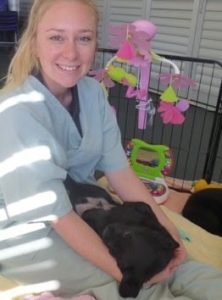
- Working dogs encounter a variety of sounds throughout their career. Some dogs may travel with their partner through busy cities while others may go to the Opera or loud concerts with their partner. With all of the different sounds a dog may encounter, we want our puppies to be comfortable and confident with many different sounds during their critical socialization period.
- When exposing pups to new sounds, think about variety. Music can include jazz, classic, country, pop, or simply putting on the radio.
- Playing the news or weather report on the TV or radio exposes pups to different voices and different types of sound.
- Music can be played quietly on a radio or computer in the same room as the whelping box for about an hour per day.
- If Mom is uncomfortable with items or will chew items up, only place them in the den under supervision for a short period of time.
Working dogs must be accepting of a variety of novel objects they may encounter in the community; so, it is important that at an early age they begin to build their reference library of unusual items, including those that move, so that they are comfortable and confident with different novel objects.
It is important for working dogs to be comfortable with walking over different types of surfaces such as grates and uneven pavements. Puppies learn quickly that walking over bumpy and open surfaces is completely normal.
It is important to have a variety of surfaces for the puppies to walk on so they do not grow accustomed to only walking over one particular surface. When selecting equipment, think of having different textures and materials.
More challenging surfaces can be added in the litter’s room to encourage them to climb and walk over different surfaces. This helps build the puppy’s confidence and also their muscles!
You may find your socialization items cover multiple objectives: for example, a textured wobble-board is both a new surface and a motion item; or tiles might be loud when puppy nails tap on them. Take this into consideration when choosing items appropriate for your puppies, and recognise that these items might be quite challenging for some pups.
Get creative – but keep in mind that the surfaces need to be age and skill appropriate. Some ideas for new surfaces could include:
- Baking trays tipped upside-down (could be slightly wobbly)
- Milk crates or pallets
- Trays with a small amount of water in them (to replicate puddles)
- Sand, bark, gravel (supervised)
- Wooden panelling
- Tiled floors (also consider the noise of the floor and the room, e.g. echoes in a bathroom)
- Balance beams
- Elevated / uneven surfaces
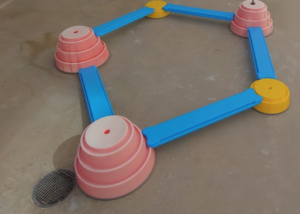

Working dogs need to be comfortable walking on unstable objects and comfortable with objects that move. It is important that puppies learn to be confident with walking on unstable objects and being around moving objects.
One useful item to introduce motion are exercise cushions or wobble boards. These tools can help pups develop muscle and motor skills and can often be adjusted to add more complexity/movement as the puppies grow. (For example, a mostly deflated cushion gives young pups an unusual but secure surface with some movement – the same cushion when fully inflated could be a suitable challenge for confident 8 week old pups). When using these tools, make sure to introduce them as secure items with very little movement so your pups aren’t frightened. Use foam or towels as padding which can easily be removed as your puppies grow.
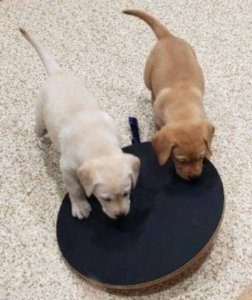
Passive exposure to TV or movies creates an unpredictable “real world” safe environment inside of the kennel. Below are examples of channels and movies and their benefits:
| Channel or Movie Examples | Benefits |
| Children cartoons | Variety of different character voices and unusual noises |
| Nature | Passive and controlled exposure to thunder, rain storms, birds chirping, water flowing, etc. |
| Musicals | Variety of singing, laughter, and noises |
| Disney Movies | Variety of singing, laughter, and noises |
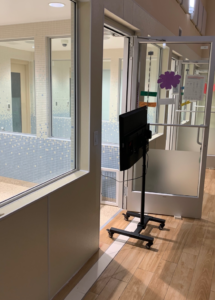
This TV is mounted on a mobile TV stand. The height of the stand can be adjusted for the age of the puppies.
Alert symbol Make sure that wires are out of the puppies’ reach when setting up.
Play TV at a low-medium volume level. Watch the puppies’ body language and turn down the volume or change to a different channel if puppies begin to show stress signs.
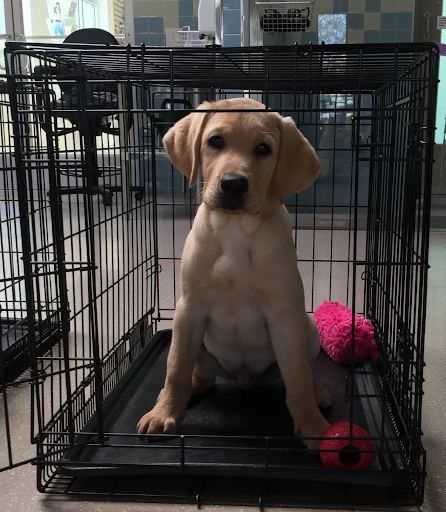
Interactive Activities
Continue to build upon the solid foundation you have created in your puppies.
- Purposeful play with and without littermates exploring novel objects, sound objects, motion objects, and surfaces
- Keep body handling, bathing other interactions with people positive.
- Continue developing handler engagement, focusing on the needs of each individual pup.
Below we have marked each activity with one to three ✓. Although all activities are important, we have highlighted activities that are particularly critical during this period of the puppies’ development. Make sure you still offer the pups a wide variety of activities and do not only focus on those with the most ✓!
It is important to start to build a solid foundation of skills. Body Handing is ongoing and involves lots of practice. It can be done in short sessions throughout the day in order to set the pup up for success by keeping skill training fun and expectations consistent. Body handling is the process of teaching our puppies to accept all parts of their body being handled while remaining calm while we touch and move all parts of their body.
This is beneficial for health/Vet visits. These skills also help with body sensitivities to equipment the pup may need to wear such as boots or coat.
Remember, Body handling should be a calm, gentle process – it’s not a time for cuddles or play – that can come later! Take extra care around your pup’s teeth, ears and paws – these areas are crucial for Body Handling but many pups find the handling of these areas strange at first.
Start by Teaching the “Close” position: (Note at younger ages puppies may need to be put in this position to begin the exercise. With age, pups can be taught how to manoeuvre into that position using the lure as described below.)
- Start by crouching on the ground with the puppy in front of you, facing you.
- Place your right knee on the ground – If pup is on a lead put the lead under your knee so both hands are free 3. Use your left hand to lure the pup from your right knee in a circle until they are between your legs facing away from you
- Tilt your lure back over the pup’s head so they go into a sit
- Mark and pay
- Put your knee down so you are kneeling with pup sitting between your legs and place your two hands on the pup’s chest
- Repeat steps 1-6 until pup is quickly and easily moving into position as you lure
- Repeat steps 1-6 but this time say the word “close” just as their bottom touches the ground Do this 3 times 9. Fade the lure and work on duration – Reward pup for being still and calm. Ignore any wriggling or mouthing.
- Do this 3 times
- Fade the lure and work on duration – Reward pup for being still and calm. Ignore any wriggling or mouthing.
Handling Method
NOTE: For pups over 3 weeks, all handling starts in the “Close” position.
Ears
- Gently hold the puppy’s chin with one hand then use the other hand to lift their ear
- Look inside and smell their ear for any signs of infection
- Repeat with the other ear
- Gentle praise, reward
Eyes
- Hold puppy’s chin gently and look at each eye
- Gentle praise, reward
Teeth
- Gently hold pup’s chin and use the other hand to lift pup’s chin on one side to look at their teeth
- Repeat on the other side
- Gentle praise, reward
Legs and paws
- Run your hand down one of pup’s legs to their paw
- Feel between the pads on their paw
- Gentle praise, reward
- Repeat with other 3 paws
Vet Restraint
- Use your left hand to gently restrain pup’s head against your chest so they are looking towards your left
- Run your right hand down the back of the pup’s right leg to their elbow then raise their leg (it should be outstretched as if for a blood draw)
- Mark and pay
- Switch so pup is facing the opposite way and the other leg is outstretched
- Gentle praise, reward
Lay Over
- Place one arm underneath pup’s front legs
- Lift your arm (therefore lifting the pup’s front legs)
- Lean down until you are lying over the top of the dog
- Remove your hand from under the pup
- Gentle praise, reward
Release cue
- Tell the puppy “Go free” and allow them to break position
- Give them a pat and plenty of praise
Previously, puppies have been exposed to new environments while their mother was present. Depending on the confidence of your pups, you can consider taking the litter for short adventures without their mother to different (but previously introduced) environments. If puppies struggle with this, keep bringing mom along for support and try again next week. You could potentially start off with the “Trolley ride with mom” activity to transport pups to a familiar area, and during the session mom can be removed briefly but kept nearby in case she’s needed.
- Please read the “Skill Building” and “Teaching New Skills” sections at the start of this page.
- Jump to our article on Developing Foundational Skills.
It is important to provide novel experiences to puppies with delayed pick up dates before they leave with their raisers. This activity provides puppies with novel experiences in a familiar environment all while using the items that you have in your building. This can be particularly helpful during adverse weather such as in warm climates during the summer months when it is too hot to walk puppies outside.
Get creative with locations around your facility that are appropriate for the pup. We have listed a few ideas here, but you should find your own Adventure Trail routes. Make sure to keep your adventures varied and fun for the pups. Make sure the pup is engaged and responsive to you. if pup becomes overwhelmed, record where and why you think this happened, end the session on a positive note, and try again tomorrow (accounting for pup’s needs!).
Before you get started
- Fill your treat pouch with appropriate kibble
- Gather leash and flat collar
- Add passive novel objects along the trail as added distractions
- Set up a crate to use at Station 3
You are now ready to retrieve your first puppy from the kennel.
Station 1: Bathroom fan and running water
Walk puppy to a bathroom
Turn on light
Turn on sink for 5 seconds
Station 2: Laundry Room
Walk puppy to the laundry room
Open and close a dryer and washer if they aren’t running
Ground tether the puppy and fold a towel
Station 3: Crate Practice
Toss a piece of kibble into one of the bottom metal crates to encourage them to go in
Close and latch the door
Walk out of the room, count to 5, then go back into the room
Take the puppy out of the kennel
Station 4: Meal Preparation Area
Walk the puppy to the room where their meals are prepared
Practice loose leash walking around the room
Reinforce loose leash walking and impulse control
Praise the puppy for a job well done and then return the puppy to their kennel.
Record notes for each puppy after you have worked with them.
- Was the puppy engaged?
- How did the puppy interact with each station?
- Did the puppy have any concerns with any stations or anything in the environment?
- How did the puppy do with loose leash walking?
Other Adventure Trail Ideas – Advanced
Office/reception visit
Walk the puppy to your facility reception area or an office.
Practice building puppy’s relationship with you, loose lead walking, and door manners.
If you see visitors, you can choose to keep puppy at a manageable distance, or introduce pup (practice 4 on the floor). Be prepared to introduce yourself and your pup, and instruct the visitors accordingly.
Garden Path walk
Beforehand, consider setting up a few novel objects along the route.
Walk the puppy to your facility’s garden area or walkway.
Practice building connection with the pup and work on reducing scavenging, if needed. Practice some known skills (sit, down).
Allow pup the time needed to explore any novel objects and encourage them to walk on any unusual surfaces.
Playground walk
Walk the puppy to a quiet playground area.
Practice building puppy’s connection with you. Encourage pup to walk on unusual surfaces (such as spongy playground material, sand, or woodchips). Work on reducing scavenging if needed. Practice some known skills (sit, down).
Puppies can now begin to get used to settling inside a closed crate. You can review further information on crate settling here.
Some tips:
- Soft bedding and interactive toys will help to promote positive associations around the crate. Make sure to supervise puppies with bedding in case they chew it. If the puppy chews bedding, remove it for the safety of the pup and make sure you provide appropriate chew toys while the pup is in the crate.
- Pup should spend time in a crate away from their littermates but around people. Puppies need to learn to settle in their crates while people are around, as this will prepare them for crate time in their raiser’s home.
- Offer the pup a stuffed Kong or nylabone.
- Start off slowly to build positive associations: gradually increase time in crate from 5 min to 30 mins. Make sure to toilet the pup before and after.
While keeping biosecurity in mind, continue to practice loose leash walking with each puppy. Once puppies have success in low distracting areas, begin to add some distractions and challenges along the way. Encourage puppies to explore items around you such as different types of surfaces.
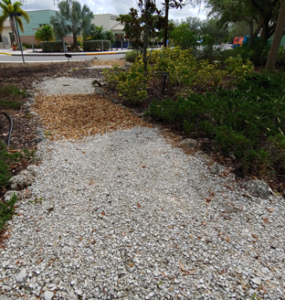
The surface trail above has different sections of sand, pebbles, and mulch. The different surfaces allows the puppies to experience walking on multiple surfaces that they could encounter in their futures as working dogs.
Below are examples of distractions and novel items that can be added to the area before the walk.
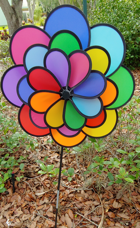
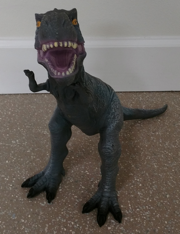
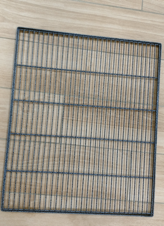
Wind spinner- Similar brightly colored wind spinners or windsocks can be strategically placed along the walking path. These items move in the wind and allow puppies to explore them along the way. Make sure to hang windsocks at the puppies’ height.
Dinosaur Toy- Place statues or objects in different places along or in the walking path. This allows puppies to encounter novel items to explore along the way. Make sure that the bar spacing is small enough that the puppy’s paws will not get stuck.
Metal Grate- Different surfaces can be placed in the walking path for puppies to walk over. Be creative and use different textures that they may encounter in their future such as tarps, metal pans, etc. Having items that they are already familiar with in different locations allows puppies to generalize from past experiences with the items.
Puppies can spend time safely secured via crate at desks during the work day. This gives puppies a new environment outside of the kennel environment to practice settling which is an important skill they will practice with their raisers. Below are a few notes for this activity. You can also consider using volunteers to prepare the areas for the puppies and to watch or check in on the puppies and return them to their kennels if needed, should the puppy be too distracted by (or distracting to!) staff.
Before bringing the puppy to the desk area:
1. Look around the area to address any safety concerns such as:
- Items that have fallen on the floor
- Wires that could possibly be in the puppy’s reach
- Trash cans
2. Set up the area
- Gather a crate or tie-down
- Gather a few safe toys for the puppy to play with
3. Give puppy time to relieve before beginning this activity
Aim to keep the puppy at the desk area for half an hour to an hour. If the puppy is unable to relax and appears restless, give the puppy an opportunity to relieve. If the behavior continues or escalates, return the puppy to their kennel. Next time, shorten the session so the puppy remains comfortable and relaxed.
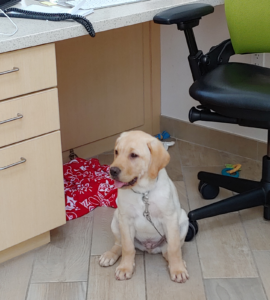
- Normal life is full of distractions, so it is important to use your handler skill to assess the best times and places to work on the pup at their skill level.
- Ensure pup is toileted prior to any on-site field trips
- Take one pup per person to the designated area. Session lengths & even locations may vary for individual puppies.
- Watch for stress signs – LEAVE IF PUP BECOMES OVERLY STRESSED or stops responding to you.
- Handled by a staff member or experienced volunteer and petted by max 3 people per session. Be aware that holding a puppy does not allow for the puppies to move away. Better to allow pup to have an escape route.
- Not to be petted by anyone initially until the pup has learned some polite meet and greets. Pup must maintain four paws on the floor and has a reliable sit duration. Should pup jump up no petting allowed. Pup should also not be petted by everyone they meet.
- It is helpful to practice polite greetings, so pup has a good understanding of what is expended prior to new people patting. Before patting is allowed get the pup in a sit position while explaining to the other person how to respond to pup.
Facility Locations
- Reception & common areas: added bonus of potential visitors as socialisation opportunities – however seriously consider Biosecurity (e.g. bring hand sanitizer) and the emotional needs of individual pups.
- Offices: Practice handler interactions as you move between offices. Say hi to some people and work on pup ignoring others by focusing on you and practicing sit or down.
Off-Location Outings
- Consider any biosecurity risks for each possible location!
- Ideas for off-location outings include:
- People’s houses: beware of and limit access to any other pets in the home.
- Park walks, bush/forest walk locations, wetlands, beaches/lakes: make sure to consider the age of the puppy and research the location beforehand to ensure it is appropriate and you will be able to help pup succeed (considering the length of the trip and possible distractions, etc).
- Shops or public areas where dogs do not commonly have access (due to increased risk until puppies are fully vaccinated) e.g. small shopping plazas
Self-Settle
- Have pup on lead
- Sit or stand without interacting with the dog
- Wait for them to settle without being cued in any way
- Mark and pay when pup lays down
- Reward them intermittently for remaining calm and in a down
- Once pup settles within 1 min you can move to the next location (see Skills Tracker)
NOTE: If they get up, just ignore them, and wait for them to settle again, then praise them but do not reward until they have been lying down for a little while.
Parking
- Have the pup on lead
- Park the pup (place your left foot on the lead at a distance that gives them little room to move around)
3.Wait for them to lie down (with hip rolled) without cueing them in any way other than having your foot on the lead
- Mark and pay when pup lays down
- Reward them intermittently for remaining calm and in a down position
NOTE: If they get up, just ignore them and wait for them to lay down again, then praise them but do not reward until they have been lying down for a little while.
Crate Settling
- Pup is to spend time in a crate away from their littermates but around people
- Offer a stuffed Kong or nylabone
- Gradually increase time in crate based on puppy’s age and capability. See Resources for further information
– (toilet pup before and after)
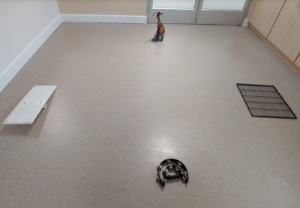
Goal: To allow puppies to encounter multiple types of objects with a handler.
To prepare the room for this activity, please complete the following steps.
- Gather a treat bag with age appropriate food to use as treats .
- Gather 1 surface, 1 sound object, 1 motion object, 1 novel object.
- Arrange the objects in a circle spread apart enough for the puppy and handler to move around comfortably.
You are now ready to retrieve the puppy you are working with.
- Allow the puppy to explore the room upon entering for up to 30 seconds.
- Call the puppy to you and ask them to explore the first object with you.
- Continue around the circle in the same manner for 2 rotations.
Goal: To accustom puppies to age-appropriate conditioning equipment to increase confidence and handler/puppy relationship.
Age-appropriate equipment includes:
- Balance pads: allow the puppies to balance with all four paws on the pad. The nobby surface lets the puppies become used to stepping on uneven surfaces.
- PVC Ladder: This elevated ladder helps with puppy proprioception, the awareness of the placement of their limbs.
Other equipment options such as brooms, mop handles, long sticks. Make sure to keep them close together for the puppy to easily step over the items.
- Small traffic cones: Walking in different directions helps strengthen puppies’ leg muscles. This exercise also requires the puppies to focus and work with their handler.
Anything that the puppies have to walk around- laundry baskets, chairs, buckets, etc. Try to keep the items small for the puppy to easily follow the handler.
- Puppy slide: Puppies gain confidence in exploring and climbing up the small stairs and going down the puppy slide.
- Wedge: This piece of equipment helps strengthen the puppy’s legs as they learn to walk on inclines. The nubby surface allows the puppies to become used to stepping on uneven surfaces.
- Large balance ball:
This uneven surface strengthens puppies’ core muscles as they balance on the equipment.
Once puppies learn to put their front paws on the ball, ask them to place all four paws on the ball for an extra challenge.
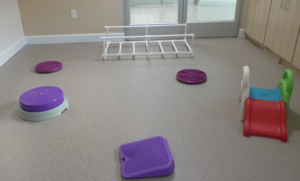
Gym Class Protocol
To prepare the education room for this curriculum, please complete the following steps.
- Gather a treat bag with age-appropriate food.
- Gather 5 age-appropriate pieces of conditioning equipment.
- Arrange the objects in a circle spread apart enough for the puppy and handler to move around comfortably.
You are now ready to retrieve the puppy you are working with.
- Allow the puppy to explore the room upon entering for up to 30 seconds.
- Call the puppy to you and use a food reward to lure them to step on the first object.
- Encourage the puppy to follow you to the next object and lure them to step on the next object.
- After completing the first rotation, use a food reward to lure the puppy to walk across or stand on each object.
- End the session on a positive note after the second rotation.
More Resources
IWDA members can access the following articles, presentations and lectures that can help you upskill and build upon your socialization program. Discover some of the science behind our Early Socialization Program. Not a member? Learn more here.
General Socialization:
- Puppy socialization for handling, presented by Doug and Colton Johnson
- Puppy socialization, presented by Jane Russenberger
- Critical periods of socialization and their impact on temperament in the dog, presented by Jane Russenberger
Measuring Behavior:
- Learn about the Behavior Check List used to systematically measure puppy behaviour, how to run a GDBART puppy test, and hone your skills in one of our recorded BCL workshops run by specialist Helen West.
Puppy socialization to improve your working dog program:
- The effects of puppy potty training on Indiscriminate relieving in training, presented by Dr Lynna Feng
- The effect of maternal style on later puppy behavior in Canine Companions dogs, presented by Brenda Kennedy
- Development and heritability of cognitive traits in Canine Companions dogs, presented by Emily Bray
- Neonatal care, presented by Emmanuel Fontaine
- These articles are relevant, but older and less content is available:
- Neuromotor development in puppies presented by Dr B. Pierce
- From Puppyhood to Adolescence: Longitudinal Cognition Study presented by K. Levy
- What helps and what hinders assistance dog/puppy raising practices?, presented by Doc Loc Mai
0 out of 5 stars
| 5 Stars | 0% | |
| 4 Stars | 0% | |
| 3 Stars | 0% | |
| 2 Stars | 0% | |
| 1 Stars | 0% |
